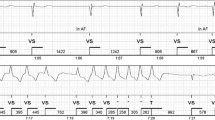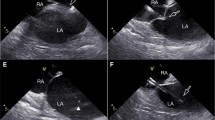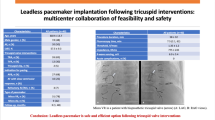Abstract
Purpose
Diagnosing atrial fibrillation (AF) is highly relevant, as specific secondary prevention is of high importance. Recently, insertable cardiac monitors (ICMs) have been introduced for continuous monitoring to detect asymptomatic episodes of AF. The detection of AF remains challenging due to a relevant incidence of artifacts. This study aimed to compare the effectivity of ICM when placed in a subcutaneous or in a submuscular localization, respectively.
Methods
We retrospectively analyzed data from 30 patients undergoing pulmonary vein isolation (PVI) for AF and consecutive ICM implantation. ICMs were implanted in two locations: either subcutaneously and parasternally (SC) or under the left major pectoral muscle (SP). Interrogations were continuously retrieved using remote monitoring and during repeated visits in our outpatient clinic. The transmission protocols were scanned for detected AF, and it was ruled by two blinded investigators, if detection was correct or incorrect.
Results
Mean age was 67 ± 10 years, 56 % men, 50 % paroxysmal AF. In 14 of the patients, the ICM was implanted at a SC localization and in 16 patients subpectorally. R-wave amplitude was significantly higher in patents with SP implantation. There were 670 transmitted protocols including 1024 episodes detected as AF. Of these, 54 % were correctly recognized as AF in the SC group. In the SP group, 85 % of the recorded episodes were correctly recognized as AF (p = 0.03). The remaining episodes in both groups showed sinus rhythm with misinterpreted artifacts.
Conclusions
To improve effectiveness of detecting AF episodes, it is useful to implant subpectorally.




Similar content being viewed by others
Abbreviations
- AF:
-
Atrial fibrillation
- EGM:
-
Electrogram
- fAF:
-
Falsely detected episode of atrial fibrillation
- ICM:
-
Intracardiac monitor
- SC:
-
Subcutaneous implantation
- SP:
-
Subpectoral implantation
- tAF:
-
Correctly detected episode of atrial fibrillation
References
Fuster, V., Rydén, L. E., Cannom, D. S., Crijns, H. J., Curtis, A. B., Ellenbogen, K. A., Halperin, J. L., Le Heuzey, J., Kay, G. N., Lowe, J. E., Olsson, S. B., Prystowsky, E. N., Tamargo, J. L., Wann, S., Smith, S. C., Jacobs, A. K., Adams, C. D., Anderson, J. L., Antman, E. M., Hunt, S. A., Nishimura, R., Ornato, J. P., Page, R. L., Riegel, B., Priori, S. G., Blanc, J., Budaj, A., Camm, A. J., Dean, V., Deckers, J. W., Despres, C., Dickstein, K., Lekakis, J., McGregor, K., Metra, M., Morais, J., Osterspey, A., & Zamorano, J. L. (2006). ACC/AHA/ESC 2006 guidelines for the management of patients with atrial fibrillation: full text: a report of the American College of Cardiology/American Heart Association Task Force on practice guidelines and the European Society of Cardiology Committee for Practice Guidelines (writing committee to revise the 2001 guidelines for the management of patients with atrial fibrillation) developed in collaboration with the European Heart Rhythm Association and the Heart Rhythm Society. Europace, 8, 651–745.
Marini, C., de Santis, F., Sacco, S., Russo, T., Olivieri, L., Totaro, R., & Carolei, A. (2005). Contribution of atrial fibrillation to incidence and outcome of ischemic stroke: results from a population-based study. Stroke, 36, 1115–1119.
Lévy, S., Maarek, M., Coumel, P., Guize, L., Lekieffre, J., Medvedowsky, J. L., & Sebaoun, A. (1999). Characterization of different subsets of atrial fibrillation in general practice in France: the ALFA study. The college of french cardiologists. Circulation., 99, 3028–3035.
Flaker, G. C., Belew, K., Beckman, K., Vidaillet, H., Kron, J., Safford, R., Mickel, M., & Barrell, P. (2005). Asymptomatic atrial fibrillation: demographic features and prognostic information from the Atrial Fibrillation Follow-up Investigation of Rhythm Management (AFFIRM) study. American Heart Journal, 149, 657–663.
Kerr, C., Boone, J., Connolly, S., Greene, M., Klein, G., Sheldon, R., Talajic, M. (1996). Follow-up of atrial fibrillation: the initial experience of the Canadian Registry of Atrial Fibrillation. European Heart Journal, (17 Suppl C), 48–51.
Israel, C. W., Grönefeld, G., Ehrlich, J. R., Li, Y., & Hohnloser, S. H. (2004). Long-term risk of recurrent atrial fibrillation as documented by an implantable monitoring device: implications for optimal patient care. Journal of the American College of Cardiology, 43, 47–52.
Savelieva, I., & Camm, A. J. (2000). Clinical relevance of silent atrial fibrillation: prevalence, prognosis, quality of life, and management. Journal of Interventional Cardiac Electrophysiology, 4, 369–382.
Liao, J., Khalid, Z., Scallan, C., Morillo, C., & O’Donnell, M. (2007). Noninvasive cardiac monitoring for detecting paroxysmal atrial fibrillation or flutter after acute ischemic stroke: a systematic review. Stroke, 38, 2935–2940.
Ziegler, P. D., Koehler, J. L., & Mehra, R. (2006). Comparison of continuous versus intermittent monitoring of atrial arrhythmias. Heart Rhythm, 3, 1445–1452.
Go, A. S., Hylek, E. M., Phillips, K. A., Chang, Y., Henault, L. E., Selby, J. V., & Singer, D. E. (2001). Prevalence of diagnosed atrial fibrillation in adults: national implications for rhythm management and stroke prevention: the AnTicoagulation and Risk Factors in Atrial Fibrillation (ATRIA) study. JAMA, 285, 2370–2375.
Healey, J. S., Connolly, S. J., Gold, M. R., Israel, C. W., Van, G., Isabelle, C., Capucci, A., Lau, C. P., Fain, E., Yang, S., Bailleul, C., Morillo, C. A., Carlson, M., Themeles, E., Kaufman, E. S., & Hohnloser, S. H. (2012). Subclinical atrial fibrillation and the risk of stroke. New England Journal of Medicine, 366, 120–129.
Mittal, S., Pokushalov, E., Romanov, A., Ferrara, M., Arshad, A., Musat, D., Preminger, M., Sichrovsky, T., & Steinberg, J. S. (2013). Long-term ECG monitoring using an implantable loop recorder for the detection of atrial fibrillation after cavotricuspid isthmus ablation in patients with atrial flutter. Heart Rhythm, 10, 1598–1604.
Hindricks, G., Pokushalov, E., Urban, L., Taborsky, M., Kuck, K., Lebedev, D., Rieger, G., & Pürerfellner, H. (2010). Performance of a new leadless implantable cardiac monitor in detecting and quantifying atrial fibrillation: results of the XPECT trial. Circulation. Arrhythmia and Electrophysiology, 3, 141–147.
Miracapillo, G., Costoli, A., Addonisio, L., Gemignani, L., Manfredini, E., Corbucci, G., Severi, S., & Barold, S. S. (2010). Left axillary implantation of loop recorder. Pacing and Clinical Electrophysiology, 33, 999–1002.
Eitel, C., Husser, D., Hindricks, G., Frühauf, M., Hilbert, S., Arya, A., Gaspar, T., Wetzel, U., Bollmann, A., & Piorkowski, C. (2011). Performance of an implantable automatic atrial fibrillation detection device: impact of software adjustments and relevance of manual episode analysis. Europace, 13, 480–485.
Kapa, S., Epstein, A. E., Callans, D. J., Garcia, F. C., Lin, D., Bala, R., Riley, M. P., Hutchinson, M. D., Gerstenfeld, E. P., Tzou, W., Marchlinski, F. E., Frankel, D. S., Cooper, J. M., Supple, G., Deo, R., Verdino, R. J., Patel, V. V., & Dixit, S. (2013). Assessing arrhythmia burden after catheter ablation of atrial fibrillation using an implantable loop recorder: the ABACUS study. Journal of Cardiovascular Electrophysiology, 24, 875–881.
Conflicts of interests and funding
None.
Author information
Authors and Affiliations
Corresponding author
Rights and permissions
About this article
Cite this article
Bergau, L., Sohns, C., Sossalla, S. et al. Submuscular implantation of insertable cardiac monitors improves the reliability of detection of atrial fibrillation. J Interv Card Electrophysiol 42, 143–149 (2015). https://doi.org/10.1007/s10840-014-9970-3
Received:
Accepted:
Published:
Issue Date:
DOI: https://doi.org/10.1007/s10840-014-9970-3




